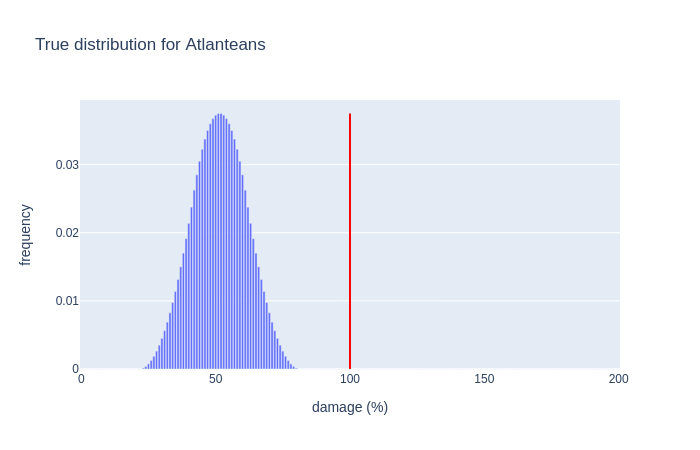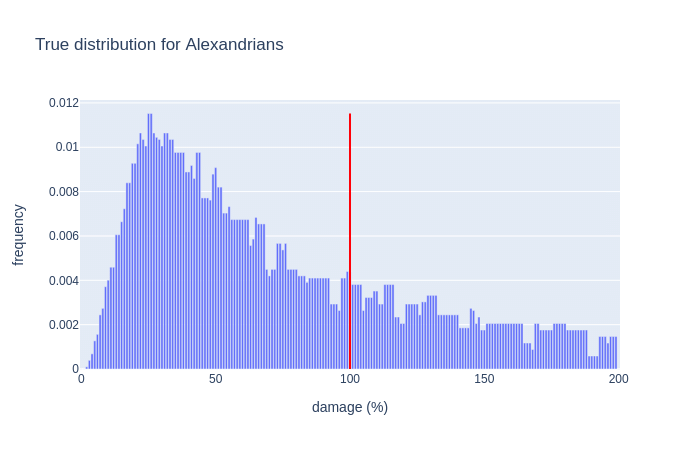D&D.Sci, problem 3 (solution)
This post is part of my "dnd.sci" series.
In part one I made the following predictions:
- Encounters are unaffected by the current month
- Encounters are unaffected by the direction of the ship
- Pirate encounters became less common near month 3, 1401
- Pirate encounters became less lethal near month 3, 1401
- There are two populations of pirates
- Crab monsters, demon whales, mermen, and Nessie are the only lethal encounters
- Crabmonsters have a geometric distribution generated by repeatedly rolling to break free or take damage
- The chance of breaking free is less than 1/40
- Harpies, kraken, Nessie, and sharks are generated by adding dice rolls, probably equal-sided
- Water elementals cause 73+d12 damage
I also proposed the following courses of action:
- Arm carpenters, install 20 oars, install 3 cannons, and buy foam swords. This leaves us with 15gp left over, and a decent chance of survival.
- Bribe the merpeople, arm the carpenters, install 20 oars, and install 1 cannon. This leaves us with 5gp left over, and gives us a very slightly better chance of survival.
Sink or swim
I fired up the web interactive. Then I faced a choice. I had generated two plans, but I hadn't committed to either one. Which one was I going to go for? I suddently didn't feel as prepared, but it was too late to go back to the drawing board. I loaded up plan A; I'd brave the merpeople.
You return home safely, and High Command orders you to design and administrate a larger test of your ideas.
The Navy's accountants and the Dockworkers' Union both support you in your future endeavours.
YAY! XD
(you had a 65.92% chance of survival.)
D:
I really felt the cold sweat from that one. I escaped with my skin, but only by the mercy of a coin toss. Let's load up plan B, I have a feeling I made the wrong call.
You return home safely, and High Command orders you to design and administrate a larger test of your ideas.
(you had a 93.28% chance of survival.)
Yep. Bad call. Really bad call. The merpeople were way more lethal than I had anticipated.
Who dunnit?
Let's take a look under the hood. Why did things happen like they happened?
The boring ones
As expected, harpies, kraken, Nessie, and sharks are all generating by adding up some dice rolls. This makes them very predictable and I got them basically spot on.
Crabmonsters
A Crabmonster repeatedly rolls 1d80 [hey! that's not a standard die!] as it tears through the ship, adding a point of damage with each roll, until it rolls a 1.
Got that one basically right, but figuring out the probability of stopping the crabmonster was critical to estimating their lethality. I didn't do that, dropping the ball at the last minute.
Pirates
Pirates are divided into two populations, each one fairly predictable on their own. The more harmful of the two (privateers hired by an enemy nation) became way less common after month 4, 1401 (because of a change of tactics, not because of a raid by our Navy). I can pat myself in the back on this one.
The very scary merpeople
Here we go. I know this is where the nasty surprise is, lay it on me.
Surface-dwellers are unaware of the intricacies of underwater society, and record both Atlantean Merfolk (1/14 of encounters) and Alexandrian Merfolk (2/21 of encounters) as "Merpeople". Fortunately, the two city-states are close enough politically that befriending one will cause them both to allow you free passage.
Atlanteans do 20+3d20 damage; Alexandrians do 1d8*1d8*1d8+1d20 damage.


…
Deep breaths now.
I'm not gonna lie, this one stings my pride. I messed up big time.
This is what the data looked like:

I got suckered in by the middle hump, and didn't notice the sneaky tail going off into the distance. I thought merpeople were not that big of a deal, maybe a ship sunk every once in a long while. Instead, out of all the ships that sink, 31% are sunk by merpeople. Out of all merpeople attacks, 21% sink a ship. This is entirely driven by the Alexandrians; Atlantean damage is capped at 80.
Lesson to learn? I need a principled approach to identifying long-tailed distributions. Need it. Desperately. This kind of thing cannot be allowed to happen to me in the wild.
On the plus side, learning a gut-level-fear of hidden tails justifies, by itself, every minute I spent writing this series.
How did my predictions do?
- (CORRECT) Encounters are unaffected by the current month
- (CORRECT) Encounters are unaffected by the direction of the ship
- (CORRECT) Pirate encounters became less common near month 3, 1401
- (CORRECT) Pirate encounters became less lethal near month 3, 1401
- (CORRECT) There are two populations of pirates
- (CORRECT) Crab monsters, demon whales, mermen, and Nessie are the only lethal encounters
- (CORRECT) Crabmonsters have a geometric distribution generated by repeatedly rolling to break free or take damage
- (CORRECT) The chance of breaking free is less than 1/40 (true p=1/80)
- (CORRECT) Harpies, kraken, Nessie, and sharks are generated by adding dice rolls, probably equal-sided
- (CORRECT) Water elementals cause 73+d12 damage
I did ok this time around, but missing how dangerous the merpeople were is major negative points.
How did others do
Pretty much everyone could tell right away which encounters were lethal and which were not. GuySrinivasan, Measure, and Simon all managed to max out their chances of survival (congratulations!).
gjm and GuySrinivasan both figured out that, since we know how many ships sank, we can check estimated lethality per encounter versus total known sinkings. GuySrinivasan used this to get a spot-on estimate of merpeople sinkings. Now that I've seen how useful that particular trick is, it'll be on my shortlist for next time.
GuySrinivasan took one look at the merpeople and noticed the tail. gjm noticed the tail, but had reasonable doubts about how far it went. You'd think that more people would take note of merpeople having tails, but this seems to have been a surprisingly rare insight.
Also, kudos to GuySrinivasan for noticing that the name of our vessel, the Grey Swan was a reference to "black swan" events. This was basically a promise that there wouldn't be any unknown-unknowns like harpies having an entirely invisible second population that shinks every ship that encounters them.
The real challenge
While I mostly solved the problem as stated, the real challenge still stands: I need a principled approach to dealing with truncated, mixed, and long tailed distributions. I have quite a few introductory and not-so-introductory statistics manuals laying around, most of which I've skimmed a little at one point or another. I don't remember any of them having advise on this, so if you have a book/article/lecture recommendation for me, send me an email!